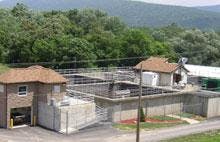SBR Systems Stand Up to Flooding Rains
Since the early 1990s, the Junction and Strodes Mill wastewater facilities in Mifflin County, PA, have been using the ABJ® ICEAS® SBR technology. Junction runs on a modified unit, while Strodes Mill uses a traditional ICEAS process. The facilities are designed to handle a combined 566,000 gpm of sewage daily, which will be increasing over the next four to six years with an anticipated expansion of the Junction Wastewater facility.
In addition to the Junction expansion, Strodes Mill is expecting increased hydraulic flows over the same period. Minor alterations to the Strodes Mill facility will be required to maintain the excellent standard of discharge to the nearby "high quality" stream. Because of its adaptable design, the ABJ process at both facilities will easily expand to suit the future needs of the community.
Both plants have also incorporated Sanitaire® fine bubble aeration systems into their facilities. According to Larry Craig, Sewer and Water Manager for both Mifflin facilities, when the fine bubble diffusers were installed, "power consumption dropped off immediately." In addition to cost savings from energy usage, Craig also noticed, "improved biosolid characteristics" and "blower run time was cut three fold."
Performance of the SBR systems was tested earlier this year during a period of heavy rains that dramatically increased flows into the two plants. Throughout the lengthy months of rains, the systems handled "several times the design capacity of peak flows," Craig said.
The ICEAS process is designed to automatically go into storm mode when needed and its decanter design can be used to support excessive inflow.
"With the ABJ decanters, you can park them and use them as primary clarifiers," Clark said. "When we know we have too much influent, we park the decanters and get adequate treatment. SBR designs from other manufacturers are not able to adequately handle such loads."
The system's versatility was able to maintain the effluent standards with "no wash outs of solids" during periods of demand that would have compromised other systems, he said.

